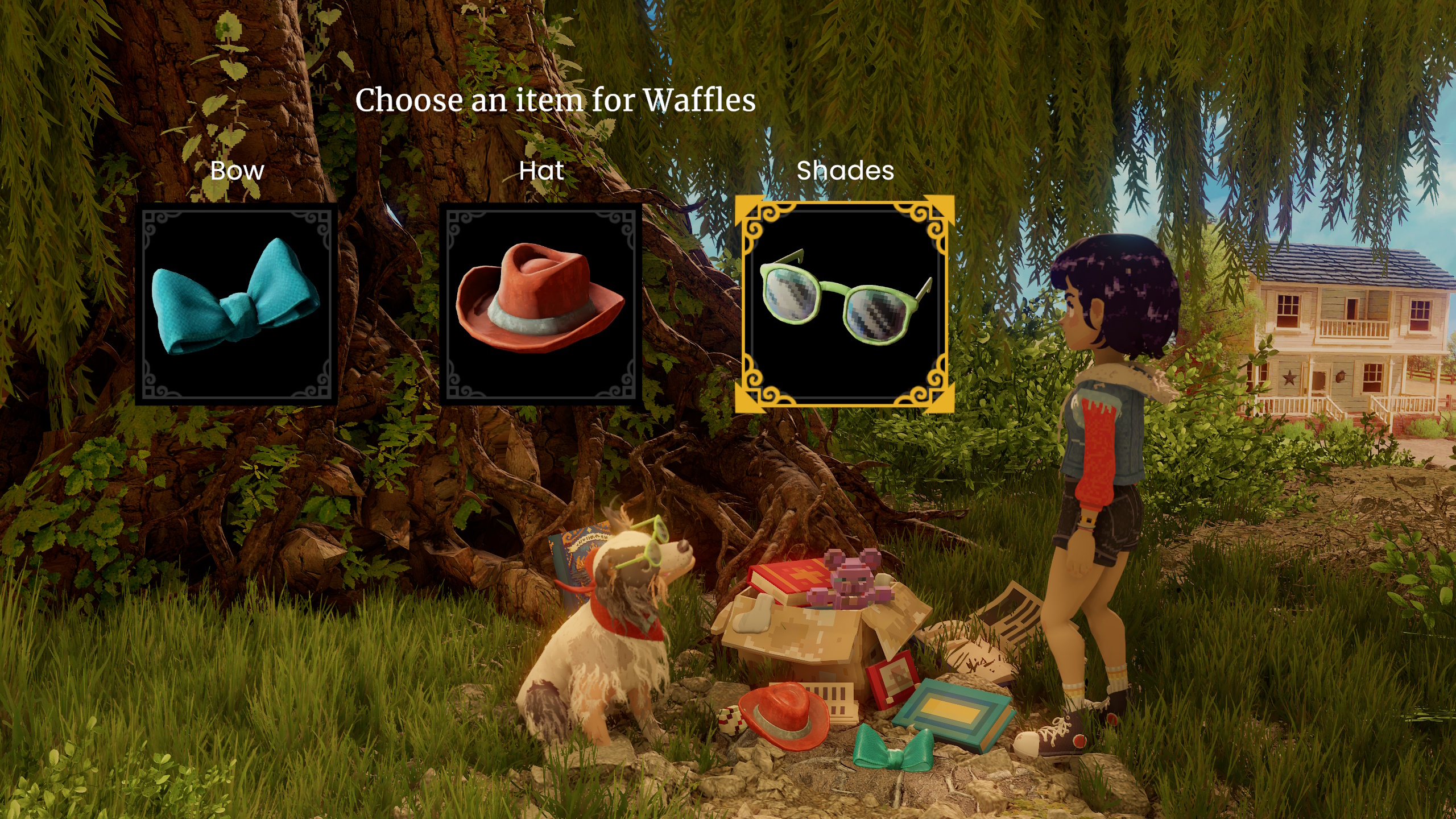Our Verdict
Beautiful, polished and painfully hollow. Ravenlok’s bones are immaculate, but lack meat or connective tissue.
PC Gamer's got your back
What is it? A hack n’ slash action-adventure inspired by Alice In Wonderland.
Release date May 4, 2023
Expect to pay $25/£19.79
Developer Cococucumber
Publisher Cococucumber
Reviewed on Windows 11, Nvidia 2080 Ti, Intel i9-9900k @ 4.9ghz, 32GB RAM
Steam Deck Unsupported
Link Official site
At least aesthetically, Ravenlok makes a great first impression with a beautifully lit farmstead backdrop, populated by detailed (but still pleasantly chunky) voxel people. A girl sits in the shade of a tree, playing with her dog. It asks you for the girl’s name, and what accessory her faithful pooch will be wearing. And then the fetch quests start, and will continue until the moment the credits roll.
It feels like an unfortunate statement of intent that despite being a hack n’ slash action game, Ravenlok begins its ersatz Alice In Wonderland adventure with legwork, bouncing between two small (but beautifully detailed) scenes, talking with just two unmoving NPCs (the young heroine’s parents) and collecting a series of items for them when - and only when - requested. The items remain stubbornly glued to the ground until such time as your quest log demands they be taken; a rule that remains frustratingly in effect through the entire game.
It’s not long before the fetch-questing leads the girl (minus her dog, which is never seen or mentioned again) into Dunia, a magical realm of classily-dressed rabbits, Tweedles (of both dum and dee varieties), and a villainous queen with an army of surly playing cards. Despite some oddly-named bespoke creatures, and the heroine being known as ‘Ravenlok’ due to her black hair, it’s a familiar, cozy Wonderland with a few playful twists, such as most of the rabbits having four arms and the Red Queen also being the Caterpillar for reasons unexplained.

Familiar as its inspirations are, it is an absolute treat to see. Ravenlok is a pseudo-retro aesthetic triumph. Every environment is packed with detail rendered in unfiltered textures, packed full of voxelized decoration and lit impeccably. It runs silky smooth, and I didn’t encounter any technical issues at all, but that’s perhaps because of Ravenlok’s limited ambition. These picture-perfect scenes are all the easier to appreciate as they’re always viewed from the perfect angle, in part because you can only pivot the camera a few degrees in each direction. It gives these fanciful environments the feel of a toy diorama or perhaps a voxelized stage play. It feels like a world meant to be observed and appreciated from a distance, not played with.
Until around half an hour in, Ravenlok is nothing but fetching objects for stationary characters, including having to rustle up your sword and shield. By the time the game introduces combat (after yet another fetch quest to locate a sword and shield), I couldn’t help but feel the game creaking a little. Then the combat tutorial begins, fading to black to relocate the player to a flatter, more open, less detailed version of the area designed entirely for fighting. This trick is only sometimes used, with some of the explorable areas having enemies to whack, but it happens often enough to feel Cococumber never quite figured out how to make the action mesh with the low-key exploration. It also doesn’t help that the combat is almost upsettingly one-note.

Snicker-snack
Simple, one-note combat isn’t inherently a bad thing, so long as that one note is a pleasant one. Mashing my way through a Dynasty Warriors game or even a LEGO Star Wars here and there can be a joy, and I am a huge fan of the Ys series. Unfortunately, the note I heard most through Ravenlok’s entire length is a sharp, artificial impact noise used for every possible combat interaction. From breaking pottery to cutting plant monsters and even shattering the arbitrary crystal MacGuffins at the end of each world, everything makes the same tinny, slightly distorted ‘tink’ sound that drowns out the music and most higher thought, and there’s nothing much more to do. There’s no jump button, no combos, just a ‘swing sword’ button.
Regrettably, almost all of Ravenlok’s combat involves little more than facing an enemy and rapidly mashing the attack button to stunlock them into oblivion. Sometimes hitting a dozen times or more per foe, that’s a lot of the same note, and punctuated with very little else. There’s a block button that seemed of very little use, and a dodge button for evading telegraphed boss attacks, but against rank-and-file monsters there’s nothing deeper to do than mash ‘attack’ as fast as you can. Once enemies get too spongy, make a quick trip back to the one NPC that can convert your accrued experience into fixed stat increases and repeat.

Even the game’s four unlockable special attacks (two melee, two projectiles, bound to the four shoulder buttons on most gamepads) do very little to spice up the recipe. Operating on cooldowns, they merely accelerate the process of sweeping up the swarms of regular enemies, and further trivialize boss battles with their generous invincibility frames. The boss fights themselves are relatively interesting (at least compared to the rank-and-file monsters), with smooth animations and well-telegraphed attacks, but the camera being fixed means that it’s all too easy to get lost behind or under larger monsters, reducing combat once more to just random flailing until you relocate your own character.

Alice In Chains
So many of these mechanical shortcomings could be excused if the beautiful backdrops and creative creature designs were used to tell an exciting story, but sadly the plot feels as threadbare as the fighting. Each newly introduced character stands in their designated location, and either explains why they need Ravenlok’s help or menaces her briefly until a fight breaks out. There’s no room for characters to develop, and dialogue - entirely unvoiced and handled through speech bubbles above characters’ heads - often happens with both participants standing side by side and facing the camera, giving it a hollow pantomime feel.
There is no drama, no escalation, and no depth.
There is no drama, no escalation, and no depth. Ravenlok herself is a void of a character, cheerfully taking on every request, and while there’s the occasional hint at darker things being afoot in Wonderland Dunia, they’re left unexplored and swiftly brushed under the rug. I would like to attribute the sinister undercurrent of glossing over these moments to authorial intent, but the vacuousness of the script (with Ravenlok declaring all the weird creatures her friends and family, despite only exchanging a few lines of dialogue with each) implies that there’s just nothing of substance here. Even for a kid’s game, it rings hollow, and a few choice grammatical errors and missing words in the script accentuate the amateur vibes.

I wish my complaints could end here, but probably the most jarring part of the entire Ravenlok experience is how disjointed everything feels. Each new environment is beautiful, but they’re often connected in the most tenuous of ways. Each of the three worlds is accessed through a teleport or NPC taking you there, which just fades to black and cuts suddenly to the new location. I could have accepted strange and surreal dreamlike links between areas, but Ravenlok just jump-cuts from one screen to the next. Jarringly, some boss fights also take place in an entirely different arena to the place where the enemy was encountered, only to cut back to ‘reality’ with the boss laying defeated.

Ravenlok’s limited content, already thinly-spread, feels like it’s stretched to breaking point in its final hour. The late-game Clock Tower area is introduced as a boss rush of sorts, requiring you to claim three coins from three floors to progress. The first two floors have fights, but the third just has an NPC casually hand you the third coin. In the very same room, you must insert them into a machine to proceed, only to have nothing happen. Turns out that you need to talk to yet another character in the same room to open the exit door for you. Any sense of escalation or drama is completely undermined, souring even the impressive environment and boss designs of the area.

A Handsome Pig
This arbitrary padding continues through the endgame, including one room where to reach a switch that’s too high up, you need to pull a lever literally two steps away that lowers it. There is so little to do in each environment that adding one extra button prompt to the scene is still doubling the amount of interaction.
The final stretch - the attack on the Queen’s castle - is where it feels like Ravenlok’s gameplay budget completely ran out. As always, the environments are immaculate, but the entire final zone is just five rooms. An entry courtyard, a hall, two side rooms and the final boss chamber, during which time the game tries to introduce a (mercifully short and easy) stealth segment and five new enemy types. So little room is afforded to this content that there’s no room to spawn all of the new enemy types at once. In order to fight them all (which is necessary to progress), I had to press switches to change which types would appear in the two side rooms.

It pains me to be as harsh on Ravenlok as I have, as clearly this is a game made with passion and clear artistic intent. But across its 5-6 hour runtime, I never shook the sense that this is an environment art showcase (and a beautiful, polished one at that) with the bare minimum of gameplay layered on top. It’s kid-friendly, both in tone and difficulty, but pales in comparison to other games aimed at the younger crowd. Like the very finest porcelain tea sets, it’s best left on the shelf to be admired, rather than brought out to entertain at the party.
Beautiful, polished and painfully hollow. Ravenlok’s bones are immaculate, but lack meat or connective tissue.

The product of a wasted youth, wasted prime and getting into wasted middle age, Dominic Tarason is a freelance writer, occasional indie PR guy and professional techno-hermit seen in many strange corners of the internet and seldom in reality. Based deep in the Welsh hinterlands where no food delivery dares to go, videogames provide a gritty, realistic escape from the idyllic views and fresh country air. If you're looking for something new and potentially very weird to play, feel free to poke him on Bluesky. He's almost sociable, most of the time.


